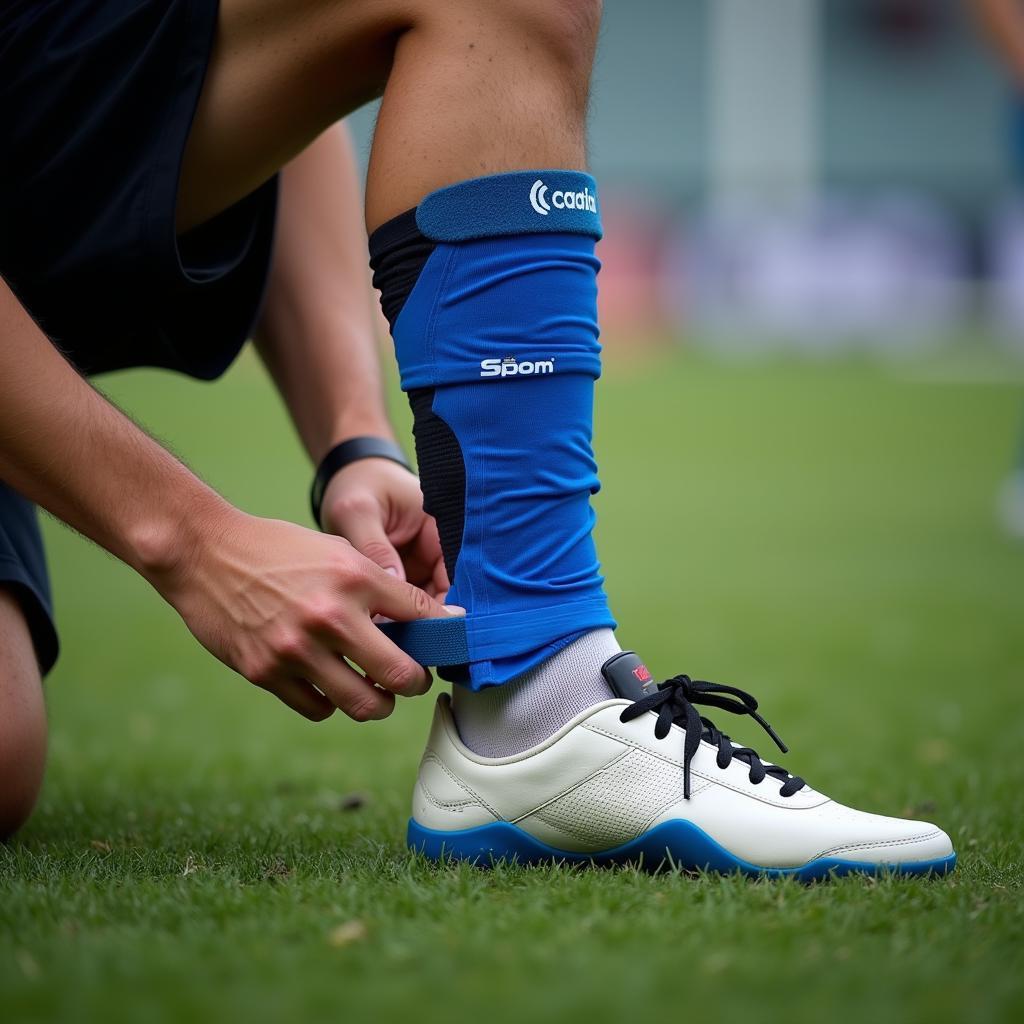The Secret Weapon: Why Footballers Love Athletic Tape
October 21, 2024As a professional footballer, I’m always looking for that extra edge on the pitch. Speed, power, and precision are all crucial, but so is protecting your body and maximizing performance. That’s where athletic tape, especially the blue kind, comes into play. You see it everywhere in the world of football, from the Premier League to local pitches, and there’s a good reason for that: it works.
 Footballer Applying Athletic Tape
Footballer Applying Athletic Tape
The Science Behind the Stick
So what’s the deal with this blue tape that’s become a staple in every footballer’s kit bag? It’s not just about looking the part, there’s actual science backing its effectiveness. The tape, often referred to as kinesiology tape, is designed to mimic the elasticity of human skin. This allows for a unique combination of support and flexibility, letting you move freely without feeling restricted.
But it’s more than just physical support. The tape’s real magic lies in its ability to interact with your body’s sensory systems. When applied correctly, it gently lifts the skin, creating microscopic space between the skin and the tissues underneath. This decompression helps improve blood flow and lymphatic drainage, reducing swelling and inflammation.
“Think of it like this,” explains Dr. James O’Connell, a leading sports physiotherapist, “the tape acts like a biomechanical cue, stimulating the nerves in the area and enhancing communication between your brain and your muscles. This can help improve muscle activation, reduce pain signals, and enhance overall stability.”
 Footballer with Taped Ankle in Action
Footballer with Taped Ankle in Action
More Than Just an Ankle Saver
While ankle support is a common use, the applications of athletic tape in football are vast and varied. From hamstring strains to knee pain and even shoulder instability, this versatile tool can be a game-changer.
- Injury Prevention: The added support helps stabilize joints and muscles, reducing the risk of sprains, strains, and other common football injuries.
- Pain Management: By reducing inflammation and providing targeted support, the tape can alleviate pain and discomfort, allowing players to train and compete at their best.
- Enhanced Performance: Improved blood flow and muscle activation can lead to better endurance, quicker recovery, and even enhanced proprioception – your body’s awareness of its position in space.
Finding Your Perfect Fit
With countless brands and variations available, choosing the right athletic tape can seem daunting. Here’s what to consider:
- Quality Matters: Opt for reputable brands known for their high-quality adhesives and materials.
- Strength and Elasticity: Different brands offer varying degrees of stretch and support, so consider your specific needs.
- Application Technique: Proper application is key to maximizing the tape’s effectiveness. Consult with a physiotherapist or athletic trainer for guidance.
Conclusion: Level Up Your Game
In the demanding world of football, every advantage counts. Athletic tape has become an essential tool for professionals and amateurs alike, offering a potent combination of injury prevention, pain management, and performance enhancement. So, whether you’re recovering from an injury or aiming to stay at the top of your game, consider adding this versatile tool to your arsenal. It might just be the secret weapon you need to take your performance to the next level.
FAQs
1. How long can I wear athletic tape?
Typically, you can wear athletic tape for up to 5 days. However, it’s important to monitor your skin for any irritation and remove the tape immediately if you experience any discomfort.
2. Can I shower with athletic tape on?
Yes, most athletic tapes are water-resistant, allowing you to shower without needing to reapply. Just pat the area dry gently afterwards.
3. Is athletic tape only for injuries?
No, many athletes use athletic tape as a preventative measure to support joints and muscles during training and competition.
4. Do I need to shave my legs before applying athletic tape?
Shaving is not necessary, but it can improve the tape’s adhesion and prevent discomfort during removal. If you choose to shave, do it a day or two beforehand to avoid skin irritation.
5. Where can I learn more about applying athletic tape correctly?
Consult with a qualified physiotherapist or athletic trainer for personalized guidance on application techniques based on your specific needs.
Need more advice on maximizing your performance? Get in touch! Contact us at 0396443476, email [email protected], or visit us at 23 Tháng 3, Đắk Nia, Gia Nghĩa, Đắk Nông, Việt Nam. Our team is available 24/7 to support your journey.